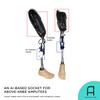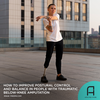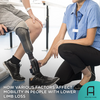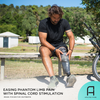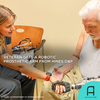Prosthetic Socket Alignment: Ideal Rotation
You just received your new prosthetic socket, and it fits amazingly well. So, why is it uncomfortable to walk? In our Prosthetic Socket Alignment series, we explore the ideal balance and alignment of your prosthetic leg. So far, we have discussed socket alignment from front to back and side to side. In this article, we discuss the rotation of your socket and its relation to the rest of your prosthesis.

If you find yourself comfortable in your prosthesis until you start walking, your socket rotation may be slightly off. Here’s how you can determine if your suspicions are correct.
Ideal prosthetic alignment
First, you need to be able to tell what the ideal prosthetic alignment is. You can do this by taking a photo of yourself from the front while standing tall and wearing your prosthetic leg. Then, using any measuring or photo editing app on your phone, bisect your socket in half, and draw a line down to your foot through your prosthetic toes. This line should fall between your prosthesis’ big toe and second toe.

Prosthetic alignment issues
If the line falls to the inside of the big prosthetic toe, then your foot’s “toe-out” or internal socket rotation is significant. This is usually true if you feel like you’re stepping into a hole or sense too much pressure over the cut end of your bone.
However, if the line falls too far to the outside of your prosthesis’ big toe and closer to the third and fourth toes, your socket is rotated externally, creating too much “toe-in.” This also creates the sensation of continually walking uphill, along with excessive knee stability.
Thankfully, both cases can be solved by consulting your prosthetist, who will perform a quick gait analysis. Then, he or she will take a 4mm wrench and rotate your socket, either internally or externally, depending on the issue. This will make you feel more comfortable and walk more efficiently.
If you have questions about socket alignment rotation, please don’t hesitate to ask us. You can leave your questions in the comments section below.






























